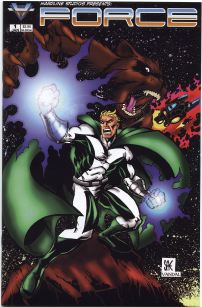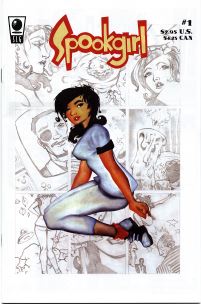








| ||||
Links du jour:
| ||||
Swimming to CambodiaBoy, I did pretty much diddly all day today.I spent the morning reading the newspaper, listening to NPR, petting the cats, doing laundry, and reading the two previous series of the comic book Chassis, which I've mentioned before. The second series even pokes fun at the near-cheesecake nature of their cover artwork (which is rather different from the interior artwork in that regard). It's pretty fun stuff, although I think they haven't quite hit their stride, since they've changed publishers twice and the series has this hesitant flow to it. I basically frittered the afternoon away on-line. Really, a whole afternoon wasted. The cats were made. But I think I needed some mindless time to myself. The evening went into television. My cow-orker Ray lent me Swimming to Cambodia, which is a monologue by actor Spaulding Gray about his brief role in The Killing Fields, his experiences in Southeast Asia around the time of its filming, and various experiences he's had in his life, wrapped around the background of the Khmer Rouge in Cambodia. The monologue is very disjointed, with many little points rather than one big one, and it works primarily because of Gray's speaking skill. I'm not sure I would recommend it, unless the subject matter sounds interesting, but it's not bad. The rest of the evening was spent watching three more Jeremy Brett Sherlock Holmes episodes from the cache that CJ lent me. I'm nearly half-done with the stack. Wow. What a waste of a day, huh? Except for do laundry and empty the trash, I never even went outside.
 Comic book time: Usually I talk about comics here which I either really like, or which I think are worth nothing for some reason. (And occasionally I just babble on about a whole stack of comics. I'm trying to get away from that.) Two of the three comics I'll consider today are comics I disliked.
The story, as you can see, is basically cheesy, without any real subtlety, and with large spots where you think, "Why the heck aren't people jumping out of their skins to see a flying man who just dashed 2000 miles across the continent?" I think the fact that he's in the LA area is supposed to suggest that people there are used to weird things, but I don't buy it. We have no idea who Greg is, what he does, or what motivates him. And the whole alien angle serves no apparent purpose than to provide some throwaway villains for our hero to kick around. If writer Wickline has a plan for this, it's not evident from this issue, and I doubt I'll stick around to try any others. Finally, the art is also quite weak, with disproportional body parts, inhuman looking faces and expressions, and... well, I think penciller Evans just isn't quite there yet. I suspect that this is the creators' first comic book, and I feel a little bad coming down so hard on it, but $2.95 is a lot to pay for a comic which basically shows that the creators need some more practice before they're ready for prime time.
The problem with this book is the writing. Again, we don't really know anything about Trixie, and even her personality is pretty much hidden from us, since the story focuses almost entirely on its eerie atmosphere. And the story doesn't really make sense: Supposedly the monkeys mutated because they were given acetone (?), there are references to baseball which don't really make any sense, and despite the danger that Trixie says the monkeys pose, she manages to dispose of them without much trouble. Hmm. I think the basic problem I have with this comic is that it's trying to be Mike Mignola's Hellboy, in which Hellboy is a demon who remembers nothing about his life before arriving on Earth, and is basically a good guy who works for a department which investigates the paranormal. However, we do know about Hellboy's background, and because of that it's obvious why he does what he does. He's loyal to his friends, and has a recognizable speech pattern which highlights his personality. And, the stories make sense. Spookgirl has a ways to go before it reaches that level.
Anyway, Martian Manhunter is about the longtime Justice League hero. He really is from Mars, although apparently from some time in the past, and he's one of very few Martians who survive at this point. He's telepathic, can change shape and become invisible, and can also fly, is strong, is invulnerable, and is vulnerable to fire (though not in the incapacitating sense that Superman is vulnerable to Kryptonite). In this series, he's faced some peculiar challenges, including the psychopathic assault of another survivor of his race, and the political machinations of the Saturnians, who are an offshoot of the Martians. It's not been especially riveting stuff, although it's been entertaining enough to keep me reading. This issue, however, is better than usual. One of the innovations to the Manhunter in recent years is the notion that since he's not human, and can change shape, he spends a lot of time in many different secret identities: As an American private eye, a Japanese businesswoman, a child in Brazil, and a cat in Venice. Due to recent events, the US government has learned all of his secret identities, and uses this leverage to try to convince the Manhunter to work for them, to use his telepathy to learn the identities of other superhumans, so that they can control them, if necessary. This story is partly about what the Manhunter does and why, and partly about Cameron Chase, an agent who investigates superhuman incidents, and whose father was a superhero who - it turns out - worked with the Manhunter in one of his earlier identities. It's a laudable story in that it doesn't shy away from the consequences of what's happened. I hope that those consequences continue to be felt in future issues, and I also hope that the Manhunter's relationship to Chase and to the organization she works for develops as time goes on, as well.
|
||





 Force #1 by Daniel R. Wickline, Brent Evans, and Vinh Teng (Hardline Studios, B&W) is - there's no way around it - a bad comic. A man named Greg wakes up in an alien facility (located in the Midwest), and finds himself with Superman-like powers. Escaping from the wolf-like aliens (who now want to kill him), he flies to California, visits an old girlfriend, and has a costume made for him, before going back to confront the aliens.
Force #1 by Daniel R. Wickline, Brent Evans, and Vinh Teng (Hardline Studios, B&W) is - there's no way around it - a bad comic. A man named Greg wakes up in an alien facility (located in the Midwest), and finds himself with Superman-like powers. Escaping from the wolf-like aliens (who now want to kill him), he flies to California, visits an old girlfriend, and has a costume made for him, before going back to confront the aliens. Spookgirl #1, on the other hand, does have some professional polish. By Mike Macropoulos (Slave Labor Graphics, B&W), it's sports retro-style artwork reminiscent of the Pander Bros (who did the Christine Spar Grendel story's art). Spookgirl is Trixie McGillicutty, an agent who investigates paranormal events, and who in this book visits a professor (who's lost her whole body except for her head) who has created intelligent, violent monkeys, which Spookgirl must deal with.
Spookgirl #1, on the other hand, does have some professional polish. By Mike Macropoulos (Slave Labor Graphics, B&W), it's sports retro-style artwork reminiscent of the Pander Bros (who did the Christine Spar Grendel story's art). Spookgirl is Trixie McGillicutty, an agent who investigates paranormal events, and who in this book visits a professor (who's lost her whole body except for her head) who has created intelligent, violent monkeys, which Spookgirl must deal with. Finally, there's Martian Manhunter #17, by John Ostrander and Tom Mandrake (DC). While I am a big fan of Ostrander's early work with First Comics (especially GrimJack), I've found his DC work to be erratic and often frustrating. I enjoyed Suicide Squad, and loved much of his work on Firestorm until the title character was revealed to be a fire elemental (how ridiculous!). Ostrander is also good friends with and often works with Mandrake, an artist who I personally find to be pretty limited in his range and expressiveness, and often not very suited to the stories Ostrander writes. I skipped their otherwise-well-regarded Spectre series largely due to the art (though also because I didn't like Ostrander's take on the character).
Finally, there's Martian Manhunter #17, by John Ostrander and Tom Mandrake (DC). While I am a big fan of Ostrander's early work with First Comics (especially GrimJack), I've found his DC work to be erratic and often frustrating. I enjoyed Suicide Squad, and loved much of his work on Firestorm until the title character was revealed to be a fire elemental (how ridiculous!). Ostrander is also good friends with and often works with Mandrake, an artist who I personally find to be pretty limited in his range and expressiveness, and often not very suited to the stories Ostrander writes. I skipped their otherwise-well-regarded Spectre series largely due to the art (though also because I didn't like Ostrander's take on the character).